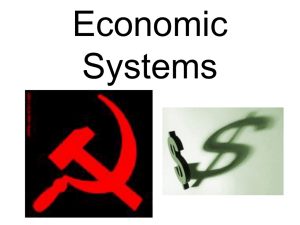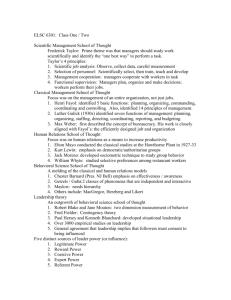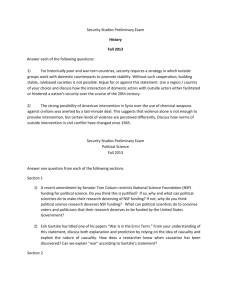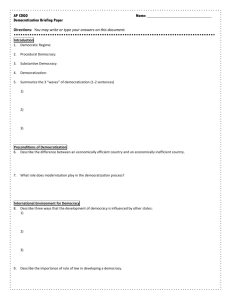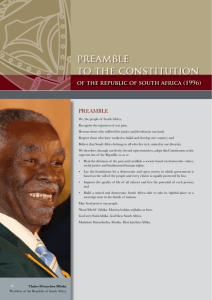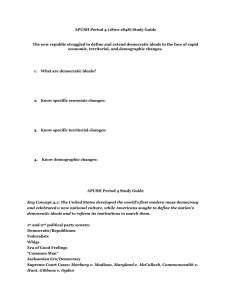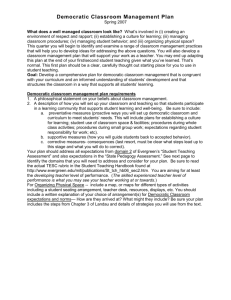Democracy and Regimes
advertisement
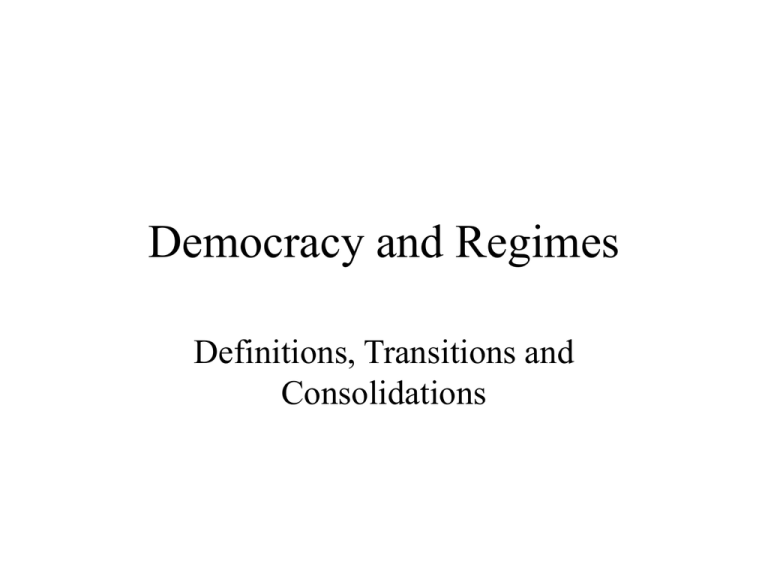
Democracy and Regimes Definitions, Transitions and Consolidations Regime Types • • • • • Democratic Authoritarian Totalitarian Post-Totalitarian Sultanic Democratic • A system or regime type in which the ultimate political authority is vested with the citizenry • Examples: USA, Canada, Sri Lanka Distribution Distribution amongst these Number of States (over time) World Population (over time) Authoritarian • Ruled by an elite group that uses repressive means to stay in power. • The state will generally ignore the actions of an individual unless it is perceived to be a direct challenge to the state. • Examples: Myanmar, Cuba, Egypt Juntas Totalitarian • The state regulates nearly every aspect of public and private behavior. • Examples: USSR (esp. under Josef Stalin), Nazi Germany, Romania under Nicolae Ceauşescu Post-Totalitarian • After the fall of Totalitarianism, government with absent or weak institutions and lacking secondary associations • Examples: Russia, Ukraine and Romania in the 1990s Sultanic • All individuals, groups and institutions are permanently subject to the unpredictable and despotic intervention of the sultan, and thus all pluralism is precarious • Examples: Saudi Arabia, Iraq under Saddam Hussein, Zaire under Mobutu Sese Seko Dimensions of Regimes • • • • Pluralism Mobilization Charismatic Leadership Pervasive Ideology Regime-Type Distribution Polyarchy • Robert Dahl’s ideal of democracy • A system where the government is completely responsive to citizens and citizens are political equals. Two basic requirements for a functional democracy • Participation • Contestation • Polyarchy, Competitive Oligarchy, Closed Hegemony, Inclusive Hegemony Contestation with Narrow Franchise • Whig Britain, esp. prior to 1832 • USA, prior to 1828 • Ancient Greece Expansion of Franchise: UK • • • • • • • • • 1258: Barons 1341: Aristocrats are represented 1832: from 10% to 20% of 21+ males 1867: 40% of 21+ males 1884: 60% of 21+ males 1918: 100% of 21+ males / 80% of 21+ females 1928: 100% of 21+ males / 100% of 21+ females 1948: ended extra vote 1969: voting age reduced to 18 Expansion of Franchise: USA • 1788: first election (under Constitution of 1787) • 1810: 10 % of males • 1828: 16% of males • 1870: former slaves/free blacks can vote • 1920: women can vote at 21 • 1924: Native Americans can vote • 1971: age requirement reduced to 18 Female Suffrage Participatory Non-Democracies • P.R. China • Saddam Hussein Iraq • USSR What to do with new classes? • Let the strongest emerge • Pluralism • Corporativism American Pluralism Mexican Corporativism Democratization Modernization Theory Civil Society • What • View of autocrats Marxian Class-Conflict Social change was often the Industrial Revolution and specifically the Peasant Question. Relevant players: Crown, Aristos, Bourg., Proletariat, Peasants. Moore: Democratic development as a struggle to: • Check arbitrary rulers • Replace arbitrary rules with rational ones • Obtain a role in rule making Moore: Conditions for democratic development • • • • The Right Balance The Right Agriculture The Right Coalition Revolutionary break with the past UK advantages • Strong and independent parliament • No serious peasant problem • Commercial and industrial interests assert themselves • Growing industrial capitalism Summary of Moore System Bourgeois strength Type of agriculture Peasant revolutionary capability Examples Democratic (Version 1) Strong Market Low UK, US Democratic (Version 2) Strong Labor Repressive High France Fascist Medium Labor Repressive Low Germany, Japan Communist Weak Labor Repressive High Russia, China Samuel Huntington’s Three Waves of Democratization • • • • • First, long wave – 1828-1926 First reverse wave – 1922-1942 Second, short wave – 1943-1962 Second reverse wave – 1958-1975 Third Wave – 1974- Which countries (Huntington) Explanations for democratization • High overall level of economic wealth • Relatively equal distribution of income and/or wealth • A market economy • Economic development and social modernization • A feudal aristocracy at some point in history • The absence of feudalism in society Explanations for democratization • • • • • • A strong bourgeoisie (capitalist class) A strong middle class High levels of literacy and education Protestantism Social pluralism Development of political contestation prior to expansion of franchise Explanations for democratization • Democratic authority structures within social groups • Low levels of civil violence • Low levels of political polarization and extremism • Political leaders committed to democracy • Experience as a British colony • Traditions of toleration and compromise Explanations for democratization • Occupation by a pro-democratic foreign power • Influence by a pro-democratic foreign power • Elite desire to emulate democratic states Explanations for democratization • Traditions of respect for rule of law and individual rights • Communal homogeneity or communal heterogeneity • Consensus on political and social values or absence thereof Factors of the Reverse Waves • • • • Weak democratic values Economic crisis Polarization Breakdown of law & order by insurgency/terrorism • Intervention/conquest by non-democratic foreign government • Demonstration effect Responsiveness vs. Stability Factors of the Third Wave • • • • • Deepening legitimacy problems Global economic growth Liberation Theology Policies of external actors Snowballing (demonstration) effect Structure and Agency • Structural factors • Agency Consolidation • Structural conditions may bring democracy • Elite settlement is often necessary to consolidate it Regime-Type Instability: Argentina • • • • • 1958 – Democratic 1962 – Military (Authoritarian) 1963 – Democratic 1966 - Military (Authoritarian) 1973 – Democratic Regime-Type Instability: Argentina • • • • 1976 - Military (Authoritarian) 1983 – Democratic 1989 – Peronist (Authoritarian) 1995 – Peronist (Consociational Democratic) • 1999 – Peronist (Competitive Democratic)
